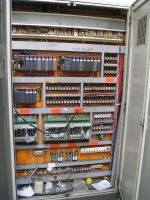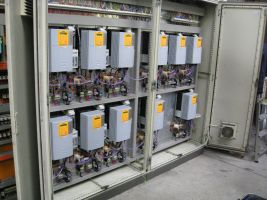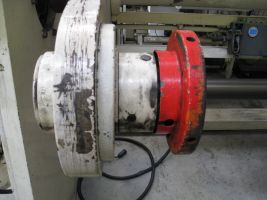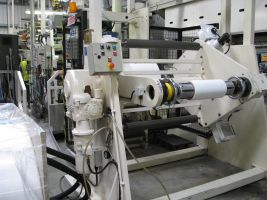Systems Labelling - TH Dixon Coater Upgrade
Project Brief
To upgrade the existing TH Dixon Coating machine which is critical for supplying this label printing company with its release papers.
In summary the upgrade was to include the following items:
- Replacement of the safety chucks on each of the three turret unwinds/rewinds
- Replacement of the machine control system including DC motor drives
- Replacement of the old pneumo-hydraulic intermediate web guide system with a modern, fully electric system
- Replacement of the 6-off 3” and 6” diameter airshafts
- Additional dancer to eliminate problem of web speed mismatch between driven laminator rollers and chill rollers
Old System
The TH Dixon Coating machine is a critical machine to Systems Labelling since it supplies the business with the release papers for the majority of its labels. The machine had become very old and somewhat unreliable, costing the company many hours of production downtime and problems. In addition to this, many of the components, primarily the Pneumo-hydraulically actuated Fife web guide system and DC motor drive cards had become outdated. So much so, that the parts and they way that they interfaced with the machine were obsolete and put the company at a high risk of loosing their main source of release papers for some time should they fail.
The long coater line comprises three turrets: a Primary Unwind, and Secondary Unwind and a Primary Rewind. A DC geared motor powers each shaft, and the drive side safety chuck was coupled rigidly through the gearbox output shaft bore. The safety chucks were considerably worn, meaning that the airshafts were not located firmly and the chucks safety was compromised to some degree.
During discussions, the Engineering Manager reported some problems that were seen due to speed mismatch between the laminating rolls and chill rolls. There was no form of closed loop tension control between these two points. This meant that the relative speed between the two adjacent sets of driven rollers could fluctuate, having a direct effect on the tension and quality of the material in that zone.
Disadvantages
- Many outdated components and interfaces mean that there is a high risk of extended downtime for the critical machine
- Badly worn safety chucks and airshafts compromise the safety to some degree
- Lack of tension control in between the laminating nip and the chill rollers has a detrimental impact on product quality
New System
The new upgrade can be split into two discrete components: electrical and mechanical. These were both completed as part of a carefully coordinated project, along with other service work and upgrades which were going on concurrently elsewhere on the machine. With detailed planning and preparation work, we were able to complete the mechanical work in 4 days and the electrical work in 7 days from starting the installation. At this point the machine was in a position to be able to run and produce product.
New system – Electrical Upgrade
A large electrical upgrade was undertaken which included the following replacements:
- New backplates and controls including relay switches etc.
- New Siemens PLC and HMI for control of existing parameters and new dancer tension control
- 11 new SSD Parker digital DC drives (4-quadrant 590P units with tacho feedback, thus eliminating the requirement for the analogue PID control cards. All drives provided with line chokes and fast acting fuses, in accordance with the drive manufacturer’s specification.
- New Coiltek Ultrasonic diameter sensors on each winder, as replacement of the old SSD Ranger ultrasonic cards
- New electrical switches and push buttons
- Integration of a new E-stop safety circuit to ensure compliance with current legislation
- New pair of Magpowr TS75-SRM in roll mounted load cells including new light weight aluminium roller. For tension control on the ‘Hogsback’.
- New electrical drawings and PLC software to provide an accurate record of the new electrical system so that future problems can be identified and rectified quickly
In short, the whole electrical system of the machine was replaced.
New system – Mechanical Upgrade
A total of six pairs of safety chucks at the unwind/rewind turrets were replaced with Boschert flange mounted 30-40 chucks. Adaptor flanges were produced to accommodate the slight interface mismatch between the old and new safety chucks, whilst still maintaining positional accuracy of the axis. A flexible element coupling was also introduced between the gearbox and the safety chuck to isolate the loads from the rolls. As an additional security measure, handwheel locks were specified on the safety chucks. This is because, being on a turret they are oriented so that they open in the loading position, but the turret then rotates over so the new roll is in the running position, meaning that the chucks will open upside down should they be forced open for some reason. Handwheel locks avoid this by positively locking the handwheel shut, until the operator consciously frees the lock to undo the chuck. The chucks also featured VT1 inserts, which can be easily and economically replaced if wear becomes a problem over time.
A new set of 6 airshafts were also supplied for the 3” and 6” core variants that the company uses. These airshafts were specified with hardened steel journals at either end of the roll. This protected the airshaft from excessive wear which was seen on the previous versions due to the lifting frame that was used during loading.
Each of the 3 old pneumo-hydraulic camber roll webguide control systems were replaced with complete, fully electric Fives North American Systems. These provided a very simple to set-up closed loop digital control from a ultrasonic edge sensor. Adaptors were manufactured to facilitate a quick changeover of the old actuators with the new servo driven ballscrew units.
A new bespoke dancer assembly was designed and manufactured to fit in the limited space envelope between the laminating rolls and chill rolls to address the problems that were experienced in that area. The dancer roller moves linearly and is controlled by a Magpowr closed loop control system which allows a precise web tension to be applied by means of a magnetic particle clutch. This clutch keeps a constant web tension according to the tension setpoint, whilst the neighbouring chiller roller drive is controlled by closed loop dancer position feedback so that exact speed matching is achieved and the dancer remains in the centre of its travel.
Advantages
- Improved reliability and serviceability of the machine
- Reduced downtime
- Increase in production
- Improved quality of product due to mechanical improvements and improved web control



